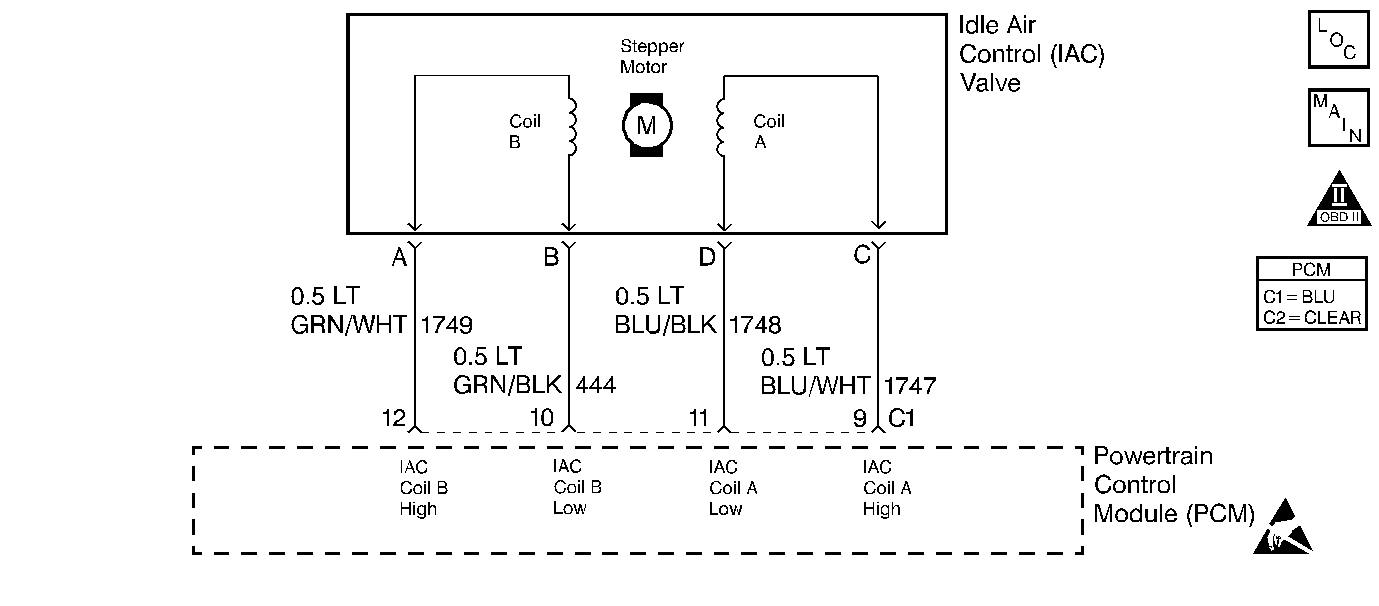
Circuit Description
The PCM controls engine idle speed by adjusting the position of the idle air control (IAC) motor pintle. The IAC is a bi-directional motor driven by two coils. The PCM sends pulses (steps) to the IAC to extend or retract the IAC pintle into a passage in the throttle body to decrease or increase air flow. The commanded IAC position (displayed in counts) can be monitored on the scan tool. A lower number of counts indicates less commanded airflow (pintle extended). This method allows highly accurate control of idle speed and quick response to changes in engine load. If the PCM detects a condition where too high of an idle speed is present and the PCM is unable to adjust idle speed by decreasing the IAC counts, DTC P0507 will set indicating a problem with the idle control system.
Conditions for Setting the DTC
| • | No VSS, TP sensor, EVAP system, Misfire, IAT sensor, Fuel Trim, Fuel Injector circuit, EGR Pintle, ECT sensor, CKP sensor or MAF sensor DTC(s) are set. |
| • | Engine Coolant Temperature is greater than 50°C (122°F). |
| • | The engine has been running for at least 2 minutes. |
| • | System voltage is between 9-16 volts. |
| • | Vehicle Speed is less than 3 mph. |
| • | Intake Air Temperature is greater than -25°C (-13°F). |
| • | The throttle is closed |
| • | Engine Speed is more than 275 RPM higher than Desired Idle. |
Action Taken When the DTC Sets
| • | The PCM will illuminate the malfunction indicator lamp (MIL) during the second consecutive trip in which the diagnostic test has been run and failed. |
| • | The PCM will store conditions which were present when the DTC set as Freeze Frame and Failure Records data. |
Conditions for Clearing the MIL/DTC
| • | The PCM will turn OFF the MIL during the third consecutive trip in which the diagnostic has been run and passed. |
| • | The History DTC will clear after 40 consecutive warm-up cycles have occurred without a malfunction. |
| • | The DTC can be cleared by using the scan tool. |
Diagnostic Aids
Check for the following conditions:
| • | Poor connection at PCM or IAC motor. Inspect harness connectors for backed out terminals, improper mating, broken locks, improperly formed or damaged terminals, and poor terminal to wire connection. |
| • | Damaged harness. Inspect the wiring harness for damage. |
| • | Vacuum leak. Check for a condition that causes a vacuum leak, such as disconnected or damaged hoses, leaks at EGR valve and EGR pipe to intake manifold, leaks at throttle body, faulty or incorrectly installed crankcase ventilation valve, leaks at intake manifold, etc. Refer to Emission Hose Routing Diagram . |
| • | Throttle body. Check for a sticking throttle plate. Also inspect the IAC passage for deposits or objects which will not allow the IAC pintle to fully extend. |
Reviewing the Fail Records vehicle mileage since the diagnostic test last failed may help determine how often the condition that caused the DTC to be set occurs. This may assist in diagnosing the condition.
Test Description
Number(s) below refer to the step number(s) on the Diagnostic Table.
-
This vehicle is equipped with a PCM which utilizes an Electrically Erasable Programmable Read Only Memory (EEPROM). When the PCM is being replaced, the new PCM must be programmed. Refer to Powertrain Control Module Replacement/Programming .
Step | Action | Value(s) | Yes | No | ||||||||||
|---|---|---|---|---|---|---|---|---|---|---|---|---|---|---|
1 | Was the Powertrain On-Board Diagnostic System Check performed? | -- | ||||||||||||
2 | Are any other DTC(s) set? | -- | Diagnose the other DTC(s) first. Refer to Powertrain Control Module Diagnosis . | |||||||||||
3 |
Does Engine Speed remain within the specified value of Desired Idle for each rpm command? | ±100 rpm | Refer to Diagnostic Aids | |||||||||||
4 |
Does each node light cycle red and green (never OFF)? | -- | ||||||||||||
5 |
Was a problem found? | -- | ||||||||||||
6 | Visually/physically inspect for the following conditions:
Does any of the above require a repair? | -- | Refer to appropriate section for on-vehicle service | |||||||||||
7 |
Was a problem found? | -- | ||||||||||||
8 | Replace IAC valve. Refer to Idle Air Control Valve Replacement . Is action complete? | -- | -- | |||||||||||
9 |
Was a problem found? | -- | ||||||||||||
Replace the PCM. Important: Replacement PCM must be programmed. Refer to Powertrain Control Module Replacement/Programming . Is action complete? | -- | -- | ||||||||||||
11 |
Does Engine Speed remain within the specified value of Desired Idle for each rpm command? | ±100 rpm | System OK |
